Paradoxurinae
The Paradoxurinae are a subfamily of the viverrids that was denominated and first described by John Edward Gray in 1864.[1] Pocock subordinated the oriental genera Paradoxurus, Paguma and Arctictis to this subfamily.[2][3]
| Paradoxurinae | |
|---|---|
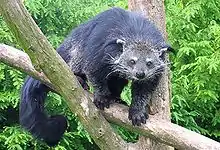 | |
| Binturong (Arctictis binturong) | |
| Scientific classification | |
| Kingdom: | Animalia |
| Phylum: | Chordata |
| Class: | Mammalia |
| Order: | Carnivora |
| Suborder: | Feliformia |
| Family: | Viverridae |
| Subfamily: | Paradoxurinae Gray, 1864 |
| Genera | |
|
see Classification | |
Classification
Living species
| Genus | Species | Distribution and IUCN Red List status | |
|---|---|---|---|
| Paradoxurus Cuvier, 1822[4] | Asian palm civet (P. hermaphroditus) (Pallas, 1777)[5].JPG.webp) |
LC[6] | |
Golden palm civet (P. zeylonensis) (Pallas, 1778)[7]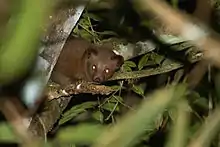 |
VU[8]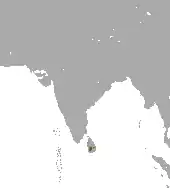 |
||
Brown palm civet (P. jerdoni) Blanford, 1885[9]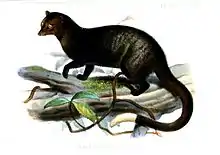 |
LC[10]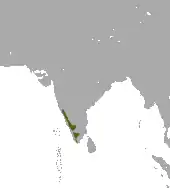 |
||
| Arctictis Temminck, 1824[11] | Binturong (A. binturong) (Raffles, 1822)[12] |
VU[13]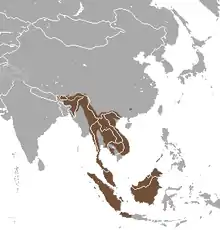 | |
| Paguma Gray, 1831[14] | Masked palm civet (P. larvata) (Smith, 1827)[15].jpg.webp) |
LC[16]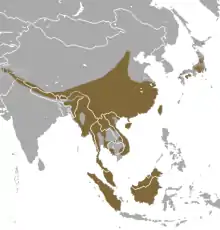 | |
| Arctogalidia Merriam, 1897[17] | Small-toothed palm civet (A. trivirgata) (Gray, 1832)[18]_(8076736823)_(cut).jpg.webp) |
LC[19]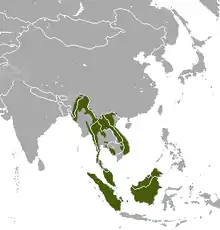 |
Phylogenetic tree
The phylogenetic relationships of Paradoxurinae are shown in the following cladogram:[20][21]
| Paradoxurinae |
| ||||||||||||||||||||||||||||||||||||||||||
References
- Gray, J. E. (1864). "A revision of the genera and species of viverrine animals (Viverridae), founded on the collection in the British Museum". Proceedings of the Zoological Society of London for the Year 1864: 502–579.
- Pocock, R. I. (1933). The rarer genera of oriental Viverridae. Proceedings of the Zoological Society of London '1933'(4): 969–1035.
- Pocock, R. I. (1939). The fauna of British India, including Ceylon and Burma. Mammalia. – Volume 1. Taylor and Francis, London. Pp. 376–439.
- Cuvier, F. (1822). "Du genre Paradoxure et de deux espèces nouvelles qui s'y rapportent". In Geoffroy Saint-Hilaire, É.; Cuvier, G. (eds.). Mémoires du Muséum d'Histoire Naturelle. 9. Paris: A. Belin. pp. 41–48.
- Pallas, P. S. (1778). "Das Zwitterstinktier Viverra hermaphrodita". In Schreber, J. C. D. (ed.). Die Säugethiere in Abbildungen nach der Natur, mit Beschreibungen. Erlangen: Wolfgang Walther. p. 426.
- Duckworth, J. W.; Timmins, R. J.; Choudhury, A.; Chutipong, W.; Willcox, D.H.A.; Mudappa, D.; Rahman, H.; Widmann, P.; Wilting, A. & Xu, W. (2016). "Paradoxurus hermaphroditus". IUCN Red List of Threatened Species. 2016: e.T41693A45217835.
- Pallas, P. S. (1778). "Der Boshond Viverra zeylonensis". In Schreber, J. C. D. (ed.). Die Säugethiere in Abbildungen nach der Natur, mit Beschreibungen. Erlangen: Wolfgang Walther. pp. 451–452.
- Duckworth, J. W.; Mudappa, D.; Pethiyagoda, R.; Woolgar, J.; de Silva Wijeyeratne, G. & Hall, J. (2016). "Paradoxurus zeylonensis". IUCN Red List of Threatened Species. 2016: e.T41694A45218119.
- Blanford, W.T. (1855). "Exhibition and description of a skull of an apparently new Species of Paradoxurus (Paradoxurus jerdoni)". Proceedings of the Zoological Society of London: 612–613.
- Mudappa, D.; Choudhury, A. & Punjabi, G. A. (2016). "Paradoxurus jerdoni". IUCN Red List of Threatened Species. 2016: e.T16104A45201757.
- Temminck, C. J. (1824). "XVII Genre Arctictis". Monographies de mammalogie. Paris: Dufour & d'Ocagne. p. xxi.
- Raffles, T. S. (1822). "XVII. Descriptive Catalogue of a Zoological Collection, made on account of the Honourable East India Company, in the Island of Sumatra and its Vicinity, under the Direction of Sir Thomas Stamford Raffles, Lieutenant-Governor of Fort Marlborough', with additional Notices illustrative of the Natural History of those Countries". The Transactions of the Linnean Society of London. XIII: 239–274.
- Willcox, D. H. A.; Chutipong, W.; Gray, T. N. E.; Cheyne, S.; Semiadi, G.; Rahman, H.; Coudrat, C. N. Z.; Jennings, A.; Ghimirey, Y.; Ross, J.; et al. (2016). "Arctictis binturong". IUCN Red List of Threatened Species. 2016: e.T41690A45217088.
- Gray, J. E. (1831). "Paguma". Proceedings of the Committee of Science and Correspondence of the Zoological Society of London. 1. London: Zoological Society of London. p. 95.
- Smith, C.H. (1827). "Gulo larvatus, the Masked Glutton". In Griffith, E. (ed.). The animal kingdom : arranged in conformity with its organization. 2. Mammalia. London: G.B. Whittaker. p. 281.
- Duckworth, J. W.; Timmins, R. J.; Chutipong, W.; Choudhury, A.; Mathai, J.; Willcox, D. H. A.; Ghimirey, Y.; Chan, B. & Ross, J. (2016). "Paguma larvata". IUCN Red List of Threatened Species. 2016: e.T41692A45217601.
- Merriam, C. H. (1897). "The generic names Ictis, Arctogale, and Arctogalidia". Science. 5 (112): 302. doi:10.1126/science.5.112.302.
- Gray, J. E. (1832). "On the family of Viverridae and its generic sub-divisions, with an enumeration of the species of several new ones". Proceedings of the Committee of Science and Correspondence of the Zoological Society of London. 2: 63–68.
- Willcox, D.H.A.; Duckworth, J. W.; Timmins, R. J.; Chutipong, W.; Choudhury, A.; Roberton, S.; Long, B.; Hearn, A. & Ross, J. (2016). "Arctogalidia trivirgata". IUCN Red List of Threatened Species. 2016: e.T41691A45217378.
- Gaubert, P. & Cordeiro-Estrela, P. (2006). "Phylogenetic systematics and tempo of evolution of the Viverrinae (Mammalia, Carnivora, Viverridae) within feliformians: implications for faunal exchanges between Asia and Africa" (PDF). Molecular Phylogenetics and Evolution. 41 (2): 266–278. doi:10.1016/j.ympev.2006.05.034. PMID 16837215. Archived from the original (PDF) on 2016-10-04. Retrieved 2019-07-01.

- Nyakatura, K. & Bininda-Emonds, O. R. P. (2012). "Updating the evolutionary history of Carnivora (Mammalia): a new species-level supertree complete with divergence time estimates". BMC Biology. 10: 12. doi:10.1186/1741-7007-10-12. PMC 3307490. PMID 22369503.
- Savage, R. J. G. (1965). "Fossil mammals of Africa: 19, The Miocene Carnivora of East Africa". Bulletin of the British Museum (Natural History). 10 (8): 239–316.
- Adrian, B.; Werdelin, L. & Grossman, A. (2018). "New Miocene Carnivora (Mammalia) from Moruorot and Kalodirr, Kenya" (PDF). Palaeontologia Electronica. 21 (1 10A): 1–19. doi:10.26879/778.
- Morales, J. & Pickford, M. (2005). "Carnivores from the Middle Miocene Ngorora Formation (13-12 Ma), Kenya" (PDF). Estudios Geológicos. 61 (3–6): 271–284. doi:10.3989/egeol.05613-668.
- Werdelin, L. (2019). "Middle Miocene Carnivora and Hyaenodonta from Fort Ternan, western Kenya" (PDF). Geodiversitas. 41 (6): 267. doi:10.5252/geodiversitas2019v41a6. S2CID 146620949.
- Dehghani, R. & Werdelin, L. (2008). "A new small carnivoran from the Middle Miocene of Fort Ternan, Kenya". Neues Jahrbuch für Geologie und Paläontologie - Abhandlungen. 248 (2): 233–244. doi:10.1127/0077-7749/2008/0248-0233.
- Grohé, C.; Bonis, L. D.; Chaimanee, Y.; Chavasseau, O.; Rugbumrung, M.; Yamee, C.; Suraprasit, K.; Gibert, C.; Surault, J.; Blondel, C.; Jaeger, J.-J. (2020). "The Late Middle Miocene Mae Moh Basin of Northern Thailand: The Richest Neogene Assemblage of Carnivora from Southeast Asia and a Paleobiogeographic Analysis of Miocene Asian Carnivorans". American Museum Novitates. 2020 (3952): 1–57. doi:10.1206/3952.1. S2CID 219296152.
This article is issued from Wikipedia. The text is licensed under Creative Commons - Attribution - Sharealike. Additional terms may apply for the media files.